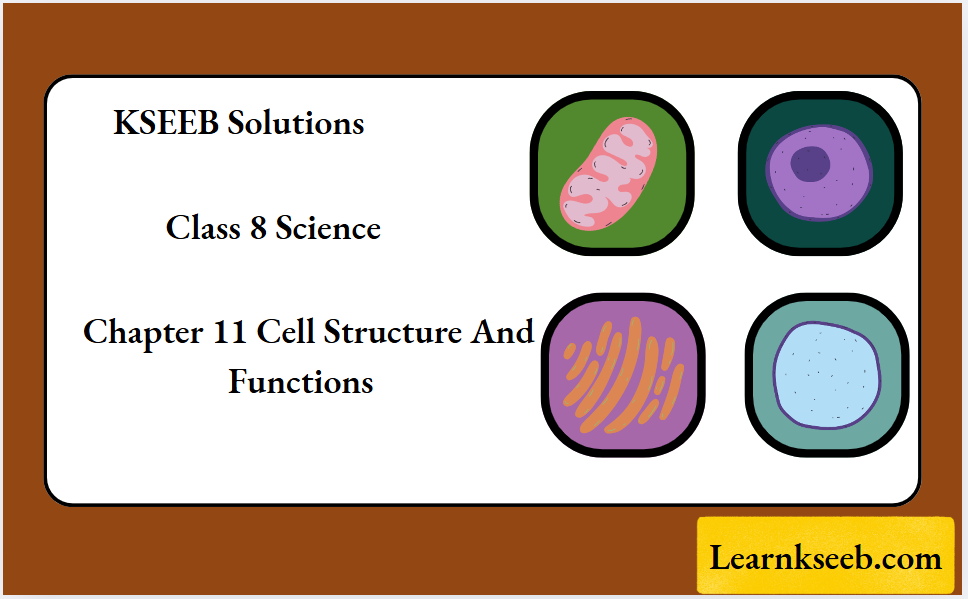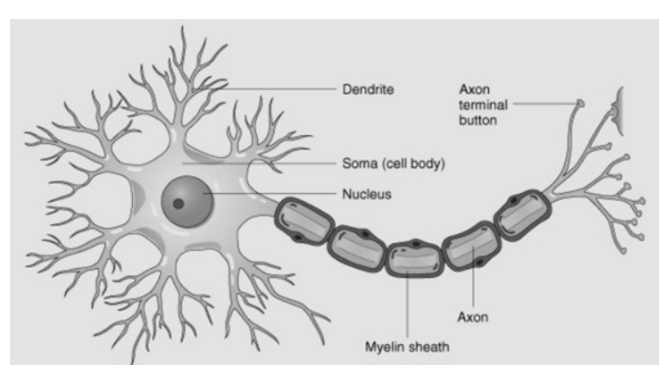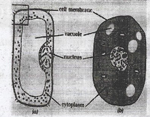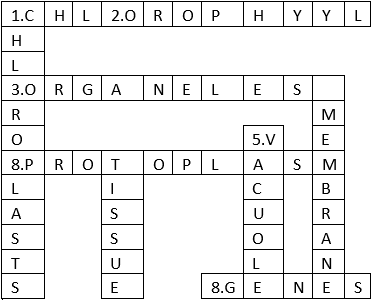KSEEB Solutions for Class 8 Science Chapter 11 Cell Structure And Functions Points To Remember
Cell: The smallest structural and functional unit of an organism, which is typically microscopic and consists of cytoplasm and a nucleus enclosed in a membrane.
All organisms are made of smaller parts called organs.
Organs are made of still smaller parts. The small- est living part of an organism is a ‘cell’.
Cells were first observed in cork by Robert Hooke in 1665.
Cells exhibit a variety of shapes and sizes.
The number of cells also varies from organism to organism.
Some cells are big enough to be seen with the unaided eye. Hens egg is an example.
Some organisms are single-celled (unicellular), while others contain a large number of cells(multicellular).
The single cell of unicellular organisms performs all the basic functions performed by a variety of cells in multi-cellular organisms.
Size of cells:
The size may be as small as a millionth of a metre or may be as large as a few centimetres.
The size of the cells has no relation with the size of the body of the animal or plant. It is related to its function.
The cell has three main parts:
The cell membrane,
Cytoplasm which contains smaller components called organelles,
The nucleus.
Cell membrane:
The basic component of a cell The cytoplasm and nucleus are enclosed within the cell membrane.
There is an outer thick layer in the cells of plants called a cell wall.
Cytoplasm: The jelly-like substance present between the cell membrane and the nucleus. Various organelles present in the cytoplasm are:
1. Mitochondria
2. Plastids (present only in plant cells)
3. Endoplasmic reticulum (ER)
4. Ribosome
5. Lysosornes
6. vacuole
7. Golgi body
8. Centrosome (present only in animal cells).
Nucleus: The nucleus is separated from the cytoplasm by a nuclear membrane. It is generally spherical in the centre of the cell.
Nuclear membrane: The nucleus is separated from the cytoplasm by a membrane called the nuclear membrane.
Nucleolus: The nucleus contains a still smaller round body known as a nucleolus.
Chromosomes: The nucleus contains thread-like structures called chromosomes. These carry genes and help in the inheritance or transfer of character from the parents to the offspring
KSEEB Solutions for Class 8 Science Chapter 11 Cell Structure and Functions
Cells without a well-organised nucleus, i.e. lacking a nuclear membrane, are called prokaryotic cells.
Cells with well-organised nuclei with nuclear membranes are called eukaryotic cells.
Plant cells differ from animal cells in having an additional layer around the cell membrane termed the cell wall.
Coloured bodies called plastids are found in plant cells only. Green plastids containing chlorophyll are called -chloroplasts.
Purcell has a big central vacuole unlike a number of small vacuoles in animal cells.

Karnataka Board Class 8 Science Chapter 11 Solutions
Class 8 Science KSEEB Cell Structure And Functions Ncert Textbook Exercises
Question 1. Indicate whether the following statement is true (T) or false (F ).
1. Unicellular organisms have a one-celled body. (T/F)
2. Muscle cells are branched. (T/F)
3. The basic living unit of an organism is an organ. (T/F)
4. Amoeba has an irregular shape. (T/F)
Answer: 1. T, 2. F, 3. F,4.T
Question 2. Make a sketch of the human nerve cell What function do nerve cells perform?
Answer: Nerve cell

The function of nerve cells: The function of the nerve cell is to receive and transfer messages, it helps to control and coordinate the working of different parts of the body.
Question 3. Write short notes on the following.
1. Cytoplasm
2. Nucleus of a cell
Answer:
1. Cytoplasm: It is the jelly-like substance found between the nucleus and the cell membrane. It contains many cell organelles. Cytoplasm along with the nucleus forms the protoplasm.
2. Nucleus: It is a spherical structure located in the Centre of the cell. It is known as the brain of the cell as it controls the activities of cells. It is separated from the cytoplasm by a membrane called a nuclear membrane.
Question 4. Which part of the cell contains organelles?
Answer: Cytoplasm contains organelles of the cell.
Question 5. Make sketches of animal and plant cells. State three differences between them.
Answer:
 Animal cell
Animal cell
1. Cell wall is absent.
2. Plasttds are absent
3. Nucleus is in the middle of the cell.
Plant cell
1. Cell wall present
2. Plastids are present.
3. Nucleus is towards the periphery.
Cell Structure and Functions Class 8 KSEEB Solutions with Answers
Question 6. State the difference between eukaryotes and prokaryotes.
Answer:
- Eukaryotes have well-organised nuclei with nuclear membranes while prokaryotes do not have well-organized nuclei.
- A prokaryotic cell is generally smaller in size than a eukaryotic cell.
Question 7. Where are chromosomes found in a cell? State their function.
Answer: Chromosomes are found in the nucleus of the cell. They carry genes and help in the inheritance of characters from the parents to the offspring.
Question 8. Cells are the basic structural units of living organisms Explain.
Answer: All living organisms are made of cells either unicellular or multicellular. The basic functions of life like respiration, assimilation and all major metabolic activities are carried inside the cell. So, the cell is known as the structural and functional unit of a living organism.
Question 9. Explain why chloroplasts are found only in plant cells.
Answer: Chloroplast contains chlorophyll which synthesizes food in plants by the process of photosynthesis. No photosynthesis occurs in animals. So, they do not contain chloroplast.
KSEEB Class 8 Science Solutions For Cell Structure And Functions
Question 10. Complete the crossword with the help of the clues given below.
Answer:
Across
1. This is necessary for photosynthesis.
3. Term for components present in the cytoplasm.
6. The living substance in the cell.
8. Units of inheritance present on the chromosomes.
Down
1. Green plastids
2. Formed by a collection of tissues
4. It.separates the contents of the cell from the surrounding medium.
5. Empty structure in the cytoplasm.
7. A group of cells.

Cell Structure And Functions Additional Questions
Question 1. _____is the outermost layer of an animal cell.
Answer: Plasma membrane/Cell membrane
Question 2. What is the name given to the green plastids?
Answer: The green plastids are called chloroplasts.
Question 3. Name two organelles present in the plant cell but not in the animal cell.
Answer: Cell walls and chloroplast are found in a plant cell but not in an animal cell.
Question 4. Which cell is observable with the unaided eye?
Answer: Ostrich egg.
Question 5. The term cell was coined by _______
Answer: Robert Hooke.
Question 6. Which organism has the smallest cell?
Answer: Bacterium mycoplasma has the smallest cell.
Question 7. Give two examples of unicellular animals.
Answer: Amoeba, paramoecium.
KSEEB Class 8 Science Cell Structure and Functions Exercise Solutions
Question 8. What is the jelly-like fluid inside the nucleus called?
Answer: The Jelly – fluid inside the nucleus is called nucleoplasm.
Question 9. Give another name for cell membranes.
Answer: Plasma membrane.
Question 10. Why are mitochondria known as the powerhouse of the cell”?
Answer: Mitochondria is known as the powerhouse of the cell because they perform the function of respiration and provide the cell with energy.
Question 11. Are the cells of an elephant larger than cells of a rat?
Answer: No, the size of the cell has no relation to the size of the body of the animal or plant.
Question 12. What is the difference between tissue and organ?
Answer: Groups of cells of the same type make up the different tissues of the organisms For example muscle tissue.
Several different types of tissues together form an organ, For example, a stomach.
Cell Structure And Functions Class 8 KSEEB Questions And Answers
Question 13. Name the organelle known as suicide bags. Why is it called so?
Answer: Lysosomes are known as suicide bags. They contain enzymes which help in breaking down or destroying various materials.
Question 14. Give the functions of cell wall.
Answer:
It provides rigidity to the cell wall.
It provides protection against plant viruses and pathogens.
Question 15. Why are plant cells more rigid in shape than animal cells?
Answer: Plant cells are more rigid in shape than animal cells due to the presence of cell wall.
Question 16. Name the largest and the smallest cells in the living world.
Answer: Largest — Ostrich’s egg Smallest— PPLO
Pleuro Pneumonia Like Organisms).
Question 17. Tomatoes are red and leaves are green. Why?
Answer :
Tomatoes are red because of chromoplasts in their cells.
Leaves are green because of chloroplasts in their cells.
Question 18. What are the functions of the cell membrane?
Answer:
It protects the cell.
It provides shape to the cell.
It allows materials to enter and leave the cell through tiny holes.
Question 19. Give the functions of the following
1. Endoplasmic reticulum
2. Golgi complex
3. Ribosornes
Answer:
1. Endoplasmic reticulum is a network of membranes, that provides a large surface area for life functions to take place.
2. Golgi complex collects and distributes the substance made in the cell and it synthesises and secretes many materials.
3. Ribosomes are the site of protein synthesis.
Question 20. Name the different parts of the nucleus and give the function of each part.
Answer:
1. Nuclear membrane: It separates the nucleus from the cytoplasm. It allows the exchange of substances between the nucleoplasm and the cytoplasm.
2. Nucleoplasm: Chromosomes and nucleoli are present in the nucleoplasm.
3. Chromosomes: Play an important role in the inheritance of characters from one generation to another.
Cell Structure And Functions Multiple Choice Questions
Question 21. Choose the correct statement with respect to unicellular organisms:
1. In unicellular organisms, tissues work in coordination to perform different functions.
2. Unicellular organisms do not require food.
3. Unicellular organisms respire and reproduce.
4. All unicellular organisms move by cilia.
Answer: 3. Unicellular organisms respire and reproduce.
Explanation: Unicellular are single-celled organisms where a single cell performs basic functions such as respiration, digestion and reproduction.
Option 1. This is wrong because tissues are a group of cells in unicellular there will be only one cell.
Option 2. This is wrong because organisms require food for their survival like any other organisms. Different unicellular uses different organisms for locomotion Example: Cilia, Pseudopodia.
Question 22. The majority of cells cannot be seen directly with our naked eyes because:
1. Organisms are generally unicellular
2. Cells are microscopic
3. Cells are present only inside the body
4. Cells are grouped into tissues
Answer: 2. Cells are microscopic
Explanation: Cells are basic units of life whose size is very small to be seen by our naked eye. Cell varies from nanometer to micrometre which requires a microscope to visualize. Hence they are called microscopic structures.
Karnataka Board 8th Science Chapter 11 Important Questions and Answers
Question 23. Read the different combinations of terms given below:
1. Cell wall, cell membrane, nucleus, plastid
2. Cell wall, nucleus, ribosome, chromosome
3. The cell membrane, mitochondria, ribosome, chromosome
4. The cell membrane, ribosome, mitochondria, and chloroplast.
The correct combination of terms with reference to an animal cell is _____
Answer: 3. Cell membrane, mitochondria, ribosome, chromosome
Explanation: Options 1. and 2. are wrong because they have a cell wall which is present only in plant cells. Option 4. is wrong because it has chloroplast which is absent in animal cells. Hence the answer is 3.
Question 24. Which one of the following terms is not a part of the nucleus?
1. Ribosome
2. Nucleolus
3. Chromosome
4. Gene
Answer: 1. Ribosome
Explanation: Ribosomes are the organelles that float in the cytoplasm. Chromosomes are the structures present in the nucleus which are composed of genes. The nucleolus is a part of the nucleus which helps in protein synthesis.
Question 25. A suitable term for the various components of cells is
1. Tissue
2. Cell organelles
3. Chromosomes
4. Genes
Answer: 2. Cell organelles
Explanation: The tissue is a group of cells which work together to perform a certain function.
Chromosomes are thread-like structures present in the nucleus which constitutes all the genes.
Gene is a unit of inheritance in living organisms. It controls the transfer of hereditary characteristics from parents to offspring. Genes are made of DNA.
Question 26. The jelly-like fluid substance present in cells is called
1. Protoplasm
2. Chromosome
3. Chloroplast
4. Cytoplasm
Answer: 4. Cytoplasm
Explanation: It is the jelly-like substance present between the cell membrane and the nucleus. Various other components, or organelles, of cells are present in the cytoplasm. These are mitochondria, Golgi bodies, ribosomes, etc.
Question 27. Read the following pairs of examples of organisms:
1. Moss and Sponge
2. Yeast and Amoeba
3. Bacteria and a blue-green alga
4. Penicillium and Spirogyra
The pair that belongs to the group prokaryotes is _____
Answer: 3. Bacteria and a blue-green alga
Explanation: Prokaryotes are organism which lacks a true nucleus and cell organelles. Other options provided are contained in eukaryotes.
Explanation Of Cell Structure And Functions In KSEEB Science
Question 28. Read the following terms and select the pair that is related to the inheritance of characters.
1. Cell wall and cell membrane
2. Chromosome and mitochondria
3. Chloroplast and cell membrane
4. Chromosome and genes
Answer: 4. Chromosome and genes
Explanation: Chromosomes and gene are responsible for the inheritance of characters. Chromosomes are present in the nucleus. Genes are the parts of chromosomes which consist of DNA.
Question 29. Choose the correct statement:
1. Genes are located in chromosomes.
2. The cell is located in the nucleus.
3. Chromosomes are located in the nucleolus.
4. Cell membrane surrounds the nucleus.
Answer: 1. Genes are located in chromosomes.
Explanation: Genes are the units of inheritance located in the chromosomes. The nucleus is located in cells but no cell is located in the nucleus. Chromosomes are present in the nucleus, not the nucleolus. The nucleus is surrounded by the nucleus membrane, not cell membrane.
KSEEB Class 8 Science Chapter 11 Textbook Solutions
Question 30. The green colour of leaves is due to the presence of the pigment
1. Chlorophyll
2. Ribosomes
3. Mitochondria
4. Chloroplast
Answer: 1. Chlorophyll
Explanation: Chlorophyll is a pigment present in chloroplasts. Chlorophyll is responsible for the green colour of leaves. Chlorophyll can absorb energy from the sun and helps in converting it to chemical energy.
Question 31. The unit of measurement used for expressing the dimension (size) of cells is:
1. Centimetre
2. Millimetre
3. Micrometre
4. Metre
Answer: 3. Micrometre
Question 32. The most important function of the cell membrane is that it:
1. Controls the entry and exit of materials from cells.
2. Controls only the entry of materials into cells.
3. Controls only the exit of materials from cells.
4. Allows entry and exit of materials without any control.
Answer: 1. Controls the entry and exit of materials from cells.
Explanation: Cell membrane facilitates the entry and exit of material from cells. The cell membrane also provides shapes to the cells.
Question 33. Paheli accidentally placed her hand over a flame and immediately pulled it back. She felt the sensation of heat and reacted due to the action of
1. Blood cells
2. Skin surface
3. Nerve cells
4. Nucleus of cells
Answer: 3. Nerve cells
Explanation: Paheli felt the sensation of heat and reacted due to the response to the stimulus by the nerve cells. Nerve cell are specialized cells, which receives and transmits signals from one part to other cells that react to stimuli by generating signals through the axons
Question 34. Which of the following cell organelle is found in all plant cells, animal cells and also in bacterial cells?
1. Chloroplast
2. Cell wall
3. Cell membrane
4. Nucleus
Answer: 3. Cell membrane
Explanation: Chloroplast and cell walls are present only in plant cells. The nucleus is absent in bacterial cells, therefore, the answer is 3. Cell membrane.
Question 35. The thread-like structures present in the nucleus are
1. Nucleolus
2. Chromosomes
3. Genes
4. Ribosomes
Answer: 2. Chromosomes
Explanation: The nucleolus is a spherical body present on the nucleus. Genes are present on chromosomes which help in the inheritance or transfer of characters from the parents to the offspring. Ribosomes are present in the cytoplasm. Hence the answer is 2. Chromosomes.
Question 36. Identify the statement which is true for cells.
1. Cells can be easily seen with the naked eye.
2. Insect’s egg is not a cell.
3. A single cell can perform all the functions in a unicellular organism.
4. The size and shape of cells are uniform in multicellular organisms
Answer: 3. A single cell can perform all the functions in a unicellular organism.
Explanation: Cells can only be seen with microscopes hence
- option 1. is wrong. An insect’s egg is a cell so
- option 2. is wrong. Cells in a multicellular organism are in different size and shape
- option 4. is wrong.
Question 37. Which of the following is not a cell?
1. Red Blood Corpuscle (RBC)
2. Bacterium
3. spermatozoa
4. Virus
Answer: 4. virus
Explanation: The virus is considered as an intermediate between living and non-living. It is not considered a cell because it cannot replicate or perform life processes outside the host cell.
Question 38. Which of the following feature will help you in distinguishing a plant cell from an animal cell?
1. Cell wall
2. Cell membrane
3. Mitochondria
4. Nucleus
Answer: 1. Cell wall
Explanation: The cell wall is present only in plant cell whereas cell wall, mitochondria and nucleus are present in both plant and animal cells. Hence cell wall help in distinguishing a plant cell from an animal cell.
Question 39. Under a microscope Paheli observes a cell that has a cell wall but no distinct nucleus. The cell that she observes is
1. A plant cell
2. An animal cell
3. A nerve cell
4. A bacterial cell
Answer: 4. A bacterial cell
Explanation: Bacterial cell is a prokaryote and it lacks a distinct nucleus and cell organelles. Hence the answer is 4. A bacterial cell.
Question 40. Cheek cells do not have
1. Cell membrane
2. Nucleus
3. Golgi apparatus
4. Plastids
Answer: 4. Plastids
Explanation: Plastids are present only in plant cells. Cheeks cells are present only in animals hence the answer is 4. Plastids.
KSEEB Class 8 Science Chapter 11 Important Questions
Question 41. Identify the correct statement.
1. Tissue is a group of dissimilar cells.
2. An organ consists of similar cells.
3. Vacuoles are not found in plant cells.
4. Prokaryotes do not have a nucleus.
Answer: 4. Prokaryotes do not have a nucleus.
Explanation: Prokaryotes are organism which lacks a true nucleus and cell organelles.
Question 42. Which of the following statements are not true for eukaryotic cells?
1. They do not have a nuclear membrane.
2. They have a well-organised nucleus.
3. They have a nuclear membrane.
4. Blue-green algae are eukaryotic cells
Answer: 4. Blue-green algae are eukaryotic cells
Explanation: Blue-green algae is a bacteria which comes under prokaryotes hence statement 4. is wrong.
KSEEB 8th Standard Science Chapter 11 Notes and Solutions
Question 43. Identify the correct statement about cells.
1. All the cells have a nucleus.
2. Cells of an organ have a similar structures.
3. Cells of tissue have a similar structure.
4. The shape of all types of cells is round.
Answer: 3. Cells of tissue have a similar structure.
Explanation: Only eukaryotic cells have well-defined nucleus hence
- Option 1. is wrong. Cells of an organ comprise of different types of the cell
- Option 2. is wrong. Cells are of different shapes and size hence option d) is wrong.
Question 44. The table given below has certain terms and four blank spaces named A, B, C and D.
| Cell Feature/Part Function |
| Amoeba A Movement |
| Plant cell Plastid B |
| C Spindle Shaped Contraction |
| NerveCell D Stimuli and response |
From the options given below choose the correct combination of terms.
1. A-Pseudopodia; B-Respirations; C-Muscle cell; D-Branched
2. A-Pseudopodia; B-Photosynthesis; C-Muscle cell; D-Branched
3. A-Contractile vacuole; B-Photosynthesis; C-Blood cell; D-Spindle shaped
4. A-Pseudopodia; B-Photosynthesis; C-Cheek cell; D-Spindle shaped
Answer: 2. A-Pseudopodia; B-Photosynthesis; C-Muscle cell; D-Branched
Explanation:
1. The pseudopods are used by Amoeba for movement and as a tool to capture prey.
2. Plastids are major organelles found in plant cells, which contain chlorophyll and can carry out photosynthesis.
3. Muscles are spindle-shaped cells, which are involved in contraction and relaxation.
4. Nerve cells are long, branched and active components of the nervous system, which functions by responding to stimuli.
Question 45. In leaves, name the cell organelle and pigment that is responsible for the green colour.
Answer: Chloroplast and Chlorophyll
Question 46. The instrument used to observe cells is ______
Answer: Microscope
Question 47. We do not sense any pain when we clip our nails or cut our hair. why?
Answer: Nails and hairs are made up of dead cells, which is not connected with nerve cells. Hence we do not feel the pain when we cut our nails or hair.
Question 48. In a cell, where are the genes located?
Answer: Genes are located in Chromosomes present within the nucleus.
Question 49. Amoeba and Paramecium belong to which category of organisms?
Answer: Protozoans
Question 50. What are the functions of the cell wall in plant cells?
Answer: Functions of cell-wall are as follows
- Acts as a protective layer.
- Provides shape to the cell.
- Control the cell expansion
- Preventing water loss from the cell.
- Provides strength and rigidity to the cell.
Question 51. Is the following statement correct? If it is wrong, correct the statement Statement :“Unicellular organisms do not respire, only multicellular organisms respire”
Answer: The statement is wrong because all kind of living organisms respire and undergo respiration process.
Question 52. Match the terms given in column I with their functions given in column II and fill the blanks given below the table:
| Column 1 Column 2 |
| Chloroplast 1. Carries hereditary characters. |
| Cell membrane 2. Controls the activities of cell |
| Nucleus 3. Site of photosynthesis |
| Chromosome 4. Controls the movement of materials into and out of cells. |
Answer:
| Column 1 Column 2 | |
| Chloroplast 3. Site of photosynthesis | |
| Cell membrane 4. Controls the movement of materials | |
| into and out of cells. | |
| Nucleus 2. Controls the activities of the cell | |
| Chromosome 1. Carries hereditary characters. |
Step-by-step Solutions for Cell Structure and Functions Class 8 Karnataka Board
Question 53. Classify the following terms into cells, tissues and organs and write in the tabular column given below.
RBC, blood vessels, blood, WBC, Nerve cell, muscle, brain, heart, hand,\ nerve.
Answer:
Cell Tissue Organ
RBC Blood Blood vessels
WBC Muscle Brain
Nerve Cell Nerve Heart Hand
Detailed Notes On Cell Structure And Functions KSEEB
Question 54. Read the following statements and write the appropriate term against each statement.
1. I control the functions of a cell. Who am I? _______
2. I am like a policeman. I do not allow anything and everything to get in and out of the cell. Who am I?________
3. I transfer characters from parents to offspring. Who am I? _____
Answer:
1. Nucleus
2. Cell membrane
3. Genes/Chromosomes

Karnataka State Board Syllabus for Class 8 Textbooks Solutions
- Chapter 1 Crop Production and Management
- Chapter 2 Microorganisms: Friend and Foe
- Chapter 3 Synthetic Fibres and Plastics
- Chapter 4 Materials: metals and Non-Metals
- Chapter 5 Coal and Petroleum
- Chapter 6 Conservation of Plants and Animals
- Chapter 7 Force and Pressure
- Chapter 8 Friction
- Chapter 9 Sound
- Chapter 10 Combustion and Flame
- Chapter 12 Reproduction in Animals
- Chapter 13 Reaching the age of Adolescence
- Chapter 14 Chemical Effects of Electric Current
- Chapter 15 Some Natural Phenomena
- Chapter 16 Light
- Chapter 17 Stars and the Solar System
- Chapter 18 Pollution of Air and Water
